Posted on March 4th, 2020 by Mary Lord
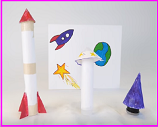 Elementary students discover the entire process that goes into designing rockets, including what real-world decisions engineers must make in such important areas as supplies, ethics, deadlines, and budgets. They also learn about the engineering design process and that the first design is almost never the final design.
Elementary students discover the entire process that goes into designing rockets, including what real-world decisions engineers must make in such important areas as supplies, ethics, deadlines, and budgets. They also learn about the engineering design process and that the first design is almost never the final design.
Read More
Filed under: Class Activities, Grades K-5, Grades K-5 | Comments Off on Learn to Build a Rocket in 5 Days or Your Money Back
Tags: aeronautical engineering, Class Activities, constraints, earth and space, engineering design proces, Grades K-5, Physical Science, rockets, trade-offs
Posted on October 21st, 2019 by ASEE
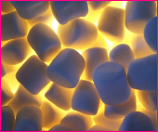 This simple catapult activity for students in grades 4 – 8 teaches them how energy is transferred when a plastic spoon is pulled back, then released, rocketing its payload — a single marshmallow.
This simple catapult activity for students in grades 4 – 8 teaches them how energy is transferred when a plastic spoon is pulled back, then released, rocketing its payload — a single marshmallow.
Read More
Filed under: Class Activities, Grades 6-8, Grades K-5, Grades K-5, Lesson Plans | Comments Off on Activity: Catapult Marshmallow Launch
Tags: catapult, Class Activities, Energy, forces and motion, Fun & Games, Grades 4 - 8, Grades K-5, Newton's Laws, NGSS, Physical Science, Physics, trebuchet
Posted on June 1st, 2018 by Mary Lord
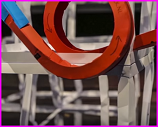 Teams of high school students learn about energy and energy transformation, then use their knowledge to design and build a paper model of the most fun and exciting roller coaster they can imagine.
Teams of high school students learn about energy and energy transformation, then use their knowledge to design and build a paper model of the most fun and exciting roller coaster they can imagine.
Read More
Filed under: Class Activities, Grades 9-12, Lesson Plans | Comments Off on Paper Roller Coasters
Tags: CCSS, Class Activities, forces, Grades 9-12, Gravity, kinetic energy, Lesson Plan, Mathematics, motion, Newton's Laws, NGSS, Physical Science, potential energy, roller coaster, vectors, velocity
Posted on December 5th, 2010 by ASEE
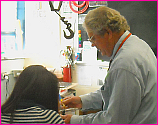 Physics teacher Ed Linz learned the value of teamwork commanding a submarine, where crew members place their lives in each others’ hands. He now collaborates with a special education instructor in teaching a mixed class of high school students.
Physics teacher Ed Linz learned the value of teamwork commanding a submarine, where crew members place their lives in each others’ hands. He now collaborates with a special education instructor in teaching a mixed class of high school students.
Read More
Filed under: Special Features | Comments Off on Feature: A Team Approach to Special Needs
Tags: Physical Science, Physics, Science Teachers, STEM education, Teachers, Team Teaching, Team-building skills, U.S. Navy
Posted on November 29th, 2010 by Jaimie Schock
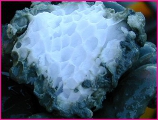 This website on gas hydrates and crystallography from the University of California-Irvine provides resources, information, and class materials for teachers. It offers information, documents, presentations, photos, and data from past programs and projects, as well as lab activities, experiments, lesson plans, software, and an online tutorial.
This website on gas hydrates and crystallography from the University of California-Irvine provides resources, information, and class materials for teachers. It offers information, documents, presentations, photos, and data from past programs and projects, as well as lab activities, experiments, lesson plans, software, and an online tutorial.
Read More
Filed under: For Teachers, Grades 6-8, Grades 9-12, K-12 Outreach Programs, Web Resources | Comments Off on Website: Gas Hydrates and Crystallography Resources
Tags: Chemical Engineering, Chemistry, National Science Foundation, Physical Science, Software
Posted on November 21st, 2010 by ASEE
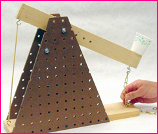 In this lesson, students in grades 4-12 learn about the history of catapults and how they work. They assemble their own catapult model, making adjustments to improve its performance. Students gain engineering experience while learning principles of physics and working with the scientific processes of experimentation and trial and error.
In this lesson, students in grades 4-12 learn about the history of catapults and how they work. They assemble their own catapult model, making adjustments to improve its performance. Students gain engineering experience while learning principles of physics and working with the scientific processes of experimentation and trial and error.
Read More
Filed under: Class Activities, Grades 6-8, Grades 6-8, Grades 9-12, Grades K-5, Grades K-5, Lesson Plans | Comments Off on Lesson: Build a Catapult
Tags: catapult, Class Activities, Engineering in History, forces and motion, Grades 5-12, Grades 6-8, Lesson Plan, Mathematics, Newton's Laws, Physical Science
Posted on July 5th, 2010 by ASEE
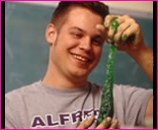 Would you believe that slime is a member of the Space Shuttle team? As an advanced viscoelastic material, slime is an amazingly lead-proof hydraulic fluid used in all critical positioning systems in space. Check out these slime recipes from the Inamori School of Engineering, Alfred University.
Would you believe that slime is a member of the Space Shuttle team? As an advanced viscoelastic material, slime is an amazingly lead-proof hydraulic fluid used in all critical positioning systems in space. Check out these slime recipes from the Inamori School of Engineering, Alfred University.
Read More
Filed under: Class Activities, Grades 6-8, Grades 9-12, Grades K-5 | Comments Off on Activity: Making Slime
Tags: Chemistry, Class Activities, Physical Science, Physics
Posted on July 5th, 2010 by ASEE
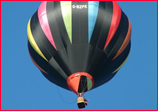 In this activity for grades 6-8, students learn about the dynamics of hot air balloons. Working in groups, they construct a working model, then use a hair dryer as the heat source to demonstrate the principle that hot air rises. Activity courtesy of the Federal Aviation Administration.
In this activity for grades 6-8, students learn about the dynamics of hot air balloons. Working in groups, they construct a working model, then use a hair dryer as the heat source to demonstrate the principle that hot air rises. Activity courtesy of the Federal Aviation Administration.
Read More
Filed under: Class Activities, Grades 6-8 | Comments Off on Activity: Float a Hot Air Balloon
Tags: Class Activities, Physical Science, Physics
Posted on July 5th, 2010 by ASEE
 The egg drop is a fun and dramatic way to get students involved in engineering design. After a discussion of safety features, students experiment packaging an egg to produce a design that will allow it to fall from a considerable height without cracking.
The egg drop is a fun and dramatic way to get students involved in engineering design. After a discussion of safety features, students experiment packaging an egg to produce a design that will allow it to fall from a considerable height without cracking.
Read More
Filed under: Grades 6-8, Grades 9-12, Lesson Plans | 2 Comments »
Tags: Engineering Design, Grades 5-12, Lesson Plan, Packaging Engineering, Physical Science, Physics, Safety engineering
 Elementary students discover the entire process that goes into designing rockets, including what real-world decisions engineers must make in such important areas as supplies, ethics, deadlines, and budgets. They also learn about the engineering design process and that the first design is almost never the final design.
Elementary students discover the entire process that goes into designing rockets, including what real-world decisions engineers must make in such important areas as supplies, ethics, deadlines, and budgets. They also learn about the engineering design process and that the first design is almost never the final design.








 This simple catapult activity for students in grades 4 – 8 teaches them how energy is transferred when a plastic spoon is pulled back, then released, rocketing its payload — a single marshmallow.
This simple catapult activity for students in grades 4 – 8 teaches them how energy is transferred when a plastic spoon is pulled back, then released, rocketing its payload — a single marshmallow. Teams of high school students learn about energy and energy transformation, then use their knowledge to design and build a paper model of the most fun and exciting roller coaster they can imagine.
Teams of high school students learn about energy and energy transformation, then use their knowledge to design and build a paper model of the most fun and exciting roller coaster they can imagine. Physics teacher Ed Linz learned the value of teamwork commanding a submarine, where crew members place their lives in each others’ hands. He now collaborates with a special education instructor in teaching a mixed class of high school students.
Physics teacher Ed Linz learned the value of teamwork commanding a submarine, where crew members place their lives in each others’ hands. He now collaborates with a special education instructor in teaching a mixed class of high school students.  This
This  In this lesson, students in grades 4-12 learn about the history of catapults and how they work. They assemble their own catapult model, making adjustments to improve its performance. Students gain engineering experience while learning principles of physics and working with the scientific processes of experimentation and trial and error.
In this lesson, students in grades 4-12 learn about the history of catapults and how they work. They assemble their own catapult model, making adjustments to improve its performance. Students gain engineering experience while learning principles of physics and working with the scientific processes of experimentation and trial and error. Would you believe that slime is a member of the Space Shuttle team? As an advanced viscoelastic material, slime is an amazingly lead-proof hydraulic fluid used in all critical positioning systems in space. Check out these slime recipes from the Inamori School of Engineering, Alfred University.
Would you believe that slime is a member of the Space Shuttle team? As an advanced viscoelastic material, slime is an amazingly lead-proof hydraulic fluid used in all critical positioning systems in space. Check out these slime recipes from the Inamori School of Engineering, Alfred University. In this activity for grades 6-8, students learn about the dynamics of hot air balloons. Working in groups, they construct a working model, then use a hair dryer as the heat source to demonstrate the principle that hot air rises. Activity courtesy of the Federal Aviation Administration.
In this activity for grades 6-8, students learn about the dynamics of hot air balloons. Working in groups, they construct a working model, then use a hair dryer as the heat source to demonstrate the principle that hot air rises. Activity courtesy of the Federal Aviation Administration. The egg drop is a fun and dramatic way to get students involved in engineering design. After a discussion of safety features, students experiment packaging an egg to produce a design that will allow it to fall from a considerable height without cracking.
The egg drop is a fun and dramatic way to get students involved in engineering design. After a discussion of safety features, students experiment packaging an egg to produce a design that will allow it to fall from a considerable height without cracking.